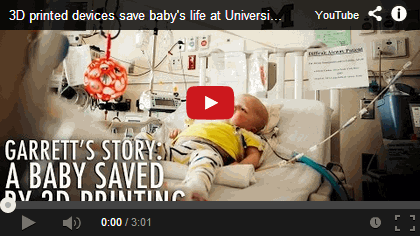
Bioresorbable splints used for just second time ever, successfully improved breathing so baby can go home for the first time
In his 18 months of life, Garrett Peterson has never gone home, spending his days in hospital beds tethered to ventilators that even at the highest settings couldn’t prevent his breathing from periodically stopping.
His condition was so tenuous that often his parents could not hold him for fear of compromising his breathing. But after surgeons at the University of Michigan’s C.S. Mott Children’s Hospital implanted 3D printed devices to open up Garrett’s airways, his parents are now planning to take their son home to their house in Utah for the very first time.
Garrett is just the second person whose life was saved with a new, bioresorbable device developed at the University of Michigan by Glenn Green, M.D., associate professor of pediatric otolaryngology and Scott Hollister, Ph.D., professor of biomedical engineering and mechanical engineering and associate professor of surgery at U-M.
Garrett has a condition called tetralogy of Fallot with absent pulmonary valve, which can put tremendous pressure on the airways. In Garrett’s case, he developed severe tracheobronchomalacia, or softening of his trachea and bronchi, and his
airways collapsed to the point that they were reduced to just small slits.
The Petersons spent months watching their child stop breathing and turn blue sometimes four to five times a day – forcing medical personnel to resuscitate him with heavy medication or other interventions.
Garrett needed to be on a ventilator at pressure levels that had reached the maximum, and he was not improving. He was often on strong medication and even had been put into a medically-induced coma because he would work against the ventilator if he was awake.
“It’s really hard to watch your child basically suffocate and pass out before you could revive him and bring him back, over and over,” says Jake Peterson, Garrett’s father.
“Nothing would stop him from turning blue. Just lifting his legs for diaper change would collapse his airways and that was it. There was nothing we could do to help him,” says Natalie Peterson, Garrett’s mother.
The Petersons had read an article in May 2013 about the first baby saved by Hollister and Green’s device and believed Garrett’s case might be similar. That baby just celebrated his second birthday and continues to be free of all symptoms related to his tracheobronchomalacia .
The Petersons contacted Green at U-M.
“We thought this could be Garrett’s chance of not only getting home but also getting off a ventilator,” Natalie Peterson says.
The Latest on: 3D printed devices
[google_news title=”” keyword=”3D printed devices” num_posts=”10″ blurb_length=”0″ show_thumb=”left”]
via Google News
The Latest on: 3D printed devices
- 3D Printed Adapter Helps You Eat Chicken Nuggets On The Highwayon April 26, 2024 at 5:00 pm
Maybe it’s to lock cams together for a timing belt change, or to work as a jig for soldering some complex device. However ... If a smart little 3D-printed adapter can make mealtime easier and save ...
- 3D printers are helping surgeons create custom cranial implantson April 26, 2024 at 11:28 am
I know that if I suffer a severe injury, especially to my skull, all I really need is a 3D printer. Now that I’m in my 40s, I’m more acutely aware of the inherent risk of injury in normal, everyday ...
- World’s largest 3D printer can print a house in under 80 hourson April 26, 2024 at 10:56 am
The University of Maine has unveiled the world's largest 3D printer, a machine capable of printing a house in 80 hours of less.
- Correction: Largest 3D Printer storyon April 26, 2024 at 8:15 am
In a story published April 23, 2024, about a new 3D printer unveiled at the University of Maine, The Associated Press erroneously identified one of the university’s partners on the ...
- Global 3D Printed Prosthetics Industry is expected to reach US$3.5 Billion, growing at an 8% annual pace By 2033 | FMIon April 26, 2024 at 5:58 am
The Global 3D Printed Prosthetics Industry is poised for significant growth, driven by rising healthcare spending, technological advancements, and increasing demand for customized prosthetic solutions ...
- No More Kodak 3D Printing: Smart International Fades Awayon April 24, 2024 at 9:03 am
It seems that another 3D printer manufacturer has faded away into the sunset. Smart International, the Argentina-based company that had licensed the Kodak brand for 3D printing, seems to have ceased ...
- Could Your Next Chair Be 3D Printed? Exploring the Viability of 3D Printing in Furniture Productionon April 24, 2024 at 8:55 am
Desktop 3D printers have undergone a revolution in the past year with the introduction of very high speed devices, in some cases able to print at speeds up to 10X of the earlier devices. This same ...
- Global 3D Printed Drugs Industryon April 23, 2024 at 7:40 am
Global 3D Printed Drugs Industry is expected to reach US$ 742.88 Million in 2032, growing at a CAGR of 9.2% From 2022 to 2032 ...
- Elastomer-based ink to 3D-print flexible devices without mechanical jointson April 20, 2024 at 12:41 pm
Elastomers have emerged as a popular material for such applications. These are synthetic polymers with a range of mechanical properties from stiff to stretchy. However, manufacturing polymers that can ...
- An ink for 3D-printing flexible devices without mechanical jointson April 18, 2024 at 10:17 am
EPFL researchers are targeting the next generation of soft actuators and robots with an elastomer-based ink for 3D printing objects with locally changing mechanical properties, eliminating the need ...
via Bing News










